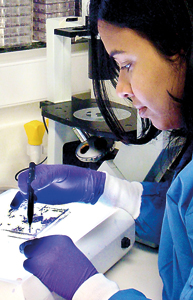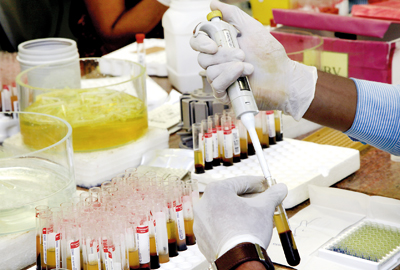Delving into the mysteries of our BBB
32-year-old Neuroscientist Dr. Adjanie Patabendige discusses the
brain with Kumudini Hettiarachchi
The brain always fascinated her and with an inquisitive mind, even as a little girl, who questioned, “Why’s that?”, it was only natural that she would attempt to unravel mysterious facets of this organ considered the most important in our bodies.
Switching from her first love which was to study medicine, she had picked on the science behind medicine. Delving into specifics how this complex organ and the vital blood-brain barrier (BBB) functions, her efforts to develop human cell culture models to reduce the number of animals used in brain infection research have paid off, for this bright young Neuroscientist.

Hard but not exhausting work
- Hard but not exhausting work
For, 32-year-old Dr. Adjanie Patabendige of the University of Liverpool, England, was recently awarded the prestigious David Sainsbury Fellowship launched just this year. Named in honour of Lord Sainsbury, the former British Minister for Science, Dr. Adjanie is among the very first four recipients to win this Fellowship which not only brings much recognition but also a grant of Rs. 40 million (£ 200,000) to pursue her work.
Her work entails spending time inside a secure, sealed, containment III laboratory “as the viruses I work with are dangerous” and she abides by strict protocols and safety standards set by the Health and Safety Executive of Britain. Getting down to the nitty-gritty of her work which she says is “hard but not exhausting” as she enjoys it, Dr. Adjanie in an exclusive e-mail interview with the Sunday Times from Liverpool, first explains the importance of the BBB. “Formed by the cells that line the small blood vessels (endothelial cells) of the brain, the BBB is the barrier that protects the brain from viruses, bacteria and toxins,” she explains, pointing out that these cells are highly specialised and tightly packed to prevent infectious agents or toxins from entering the brain. The BBB is also important in drug development because most of the potentially useful drugs that could treat brain diseases cannot get through this barrier.
Waxing eloquent on the BBB, Dr. Adjanie does not hide her admiration for it. “I’m fascinated about the BBB in particular as it’s such an amazing structure. Just imagine, none of us would survive if we didn’t have a functioning BBB! Not only does this barrier stop anything nasty from getting into the brain but it also pumps out waste/toxic products that build up inside the brain back to the blood stream.
“The BBB also regulates the entry of nutrients such as glucose and amino acids to the brain. So, it contributes to the normal neuronal function. It’s the brain’s ‘gatekeeper’.
The existence of a BBB was only discovered about 100 years ago, so it’s a relatively new area of brain research. We still have a long way to go before we fully discover the intricate details of the structure and function of the BBB,” she stresses.
With infections including Dengue, Human Immunodeficiency Virus (HIV) and Japanese Encephalitis (JE) being able to either disrupt or damage the BBB, these viruses gain a “free pass” into the brain, causing severe disease, the Sunday Times learns.
“The problem we have as scientists is that we don’t know how exactly these viruses get into the brain,” laments Dr. Adjanie. So in attempts to work out the puzzle, scientists have been experimenting on animals such as monkeys, rats and mice because of a lack of human cell-based BBB models.
Infecting these animals with viruses during these tests, according to Dr. Adjanie, causes them to suffer from leg paralysis, muscle tremors, lethargy, hunched back, seizures, coma and even death. More than 126,000 animals have been used in the last 10 years for encephalitis research and another 3,500 to check the role of the BBB in encephalitis.
“Therefore, there is an urgent need for good quality human cell-based BBB models. One advantage of using a cell-based model is that we can look into how these viruses cross the BBB to enter the brain, which is difficult to do in animals because of the complex nature of the BBB,” she points out, adding that although there are some good quality cell-based BBB models, most of them are only two-dimensional (2D) and based on animal cells.
It was not too long ago that she too developed two such models: A pig model at King’s College London, University of London, during her Ph.D and a BBB model using human brain cells at the Institute of Infection & Global Health, University of Liverpool.
Going back to how the BBB lured her, Dr. Adjanie says that bent on pursuing a career in neuroscience research she was into the second year of the specialist neuroscience degree at King’s College London, when a professor who assessed their neurophysiology essays contacted the top 10 students who had done exceptionally well. When asked whether anyone would be interested in a summer research project on BBB, “I jumped at the chance. That was the start of my career in BBB research”.
With two more such research projects on the BBB in her final year as well, after graduation she had been offered a Ph.D project at the same laboratory during which she developed a novel cell-based BBB model using cells from pig brains. “This was a big success and now several research groups and pharmaceutical companies in the UK and overseas are using this model,” she says.
However, not satisfied with what she has achieved so far her sights are set on replicating the infection in the human brain in a realistic cell environment.
“I plan to develop a 3D human BBB model using several cell types that are important for the BBB,” says Dr. Adjanie.
When the Sunday Times wondered how she would obtain human brain cells, she is quick to point out that they would be from excess tissue removed from patients undergoing brain surgery. “This 3D model will essentially have tube like structures, similar to brain blood vessels and I will have human serum (blood from donors) pumped through these tubes to mimic blood flow in the brain. I will then inject viruses to investigate how they cross the BBB and how these viruses damage the barrier and to what extent. We also have several pharmaceutical companies interested in testing some potential anti-viral drugs on this system as there are no effective anti-viral treatments for any of these infections.”
Referring to her latest achievement in securing the David Sainsbury Fellowship, this Neuroscientist explains that it was awarded by the National Centre for the Replacement, Refinement and Reduction of Animals in Research (NC3Rs), which is funded by the British government, major medical and scientific research councils and pharmaceutical companies.
She was “delighted” as the Fellowship not only recognises the value of her research but also puts her well and truly into the category of world-class research.
Conceding that the Fellowship is one of the “highlights of my career” she says that there have not been many lows, except the frustrations she experienced during the phase where she was unable to publish her Ph.D research because of Intellectual Property (IP) restrictions.
Calling that “a real pain”, Dr. Adjanie explains that the BBB model she developed during her Ph.D was so good that King’s College London didn’t want her to publish anything until the IP issues were sorted. “The lab I did my Ph.D at was generating research income through this model as several pharmaceutical companies and academic researchers were interested in using it. So, even though I was thrilled that my Ph.D produced such good results, it was pretty frustrating not being able to publish. In academia there’s a saying: ‘Publish or perish’. My Ph.D research has just been published, so I’m in no danger of perishing anytime soon!”
Not a person to have her nose buried in books all the time, it has not been all work and no play for Dr. Adjanie during her childhood in Sri Lanka. Born in London, but returning to Sri Lanka soon after with her Economic Honours graduate parents, Ossie Patabendige and Manel de Silva, she was not only very studious and first in class almost every year at Gothami Balika Vidyalaya, Colombo 10, but engaged in “lots of extra-curricular activities”.
“I also played the piano and we still have that old piano at our family home in Pepiliyana,” she reminisces, hastening to add that she was also a fan of theatre. “I did a little bit of directing and acting at school,” says Dr. Adjanie, reliving the times when they would go to many stage dramas, including the great Sarachchandra’s creations. ‘Mano Uncle’ (Jayalath Manoratne) and ‘Diga Uncle’ (Nissanka Diddeniya) are my father’s university friends.
Now married to Guminda Hewagama and having “beautiful Tanya” who is just four years old, this wife, mother and academic, does concede that it’s not easy to be successful in academia and have a good family life, especially for women.
Managing home and work which also includes supervision and training of Ph.D students and junior researchers, Dr. Adjanie wholeheartedly accepts that “it helps to have excellent time management skills and a supportive husband!”
Acknowledging that she does have a good work-life balance, she, however, is quick to point out that for most women scientists, it is very difficult.
For Dr. Adjanie the path is clear. “I believe my research will lead to a better understanding of how these deadly viruses get into the brain and potentially discover new treatment strategies. It will also help reduce the number of animals used for these types of experiments,” she says.
There is, however, one small issue that niggles her even after so many years………the dreadful weather in Britain, though the country has much to offer and the countryside is amazingly beautiful. “I still can’t bear the weather,” she says ruefully.
A note of regret is apparent when she says……“If there was ever an opportunity and facilities to do high quality BBB research in Sri Lanka, I would take it. I miss the tropical climate and the lovely beaches.”
comments powered by Disqus
























